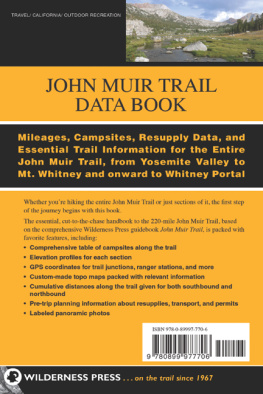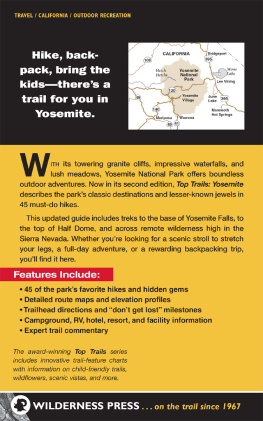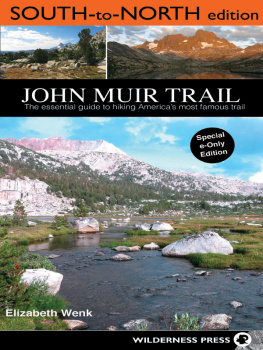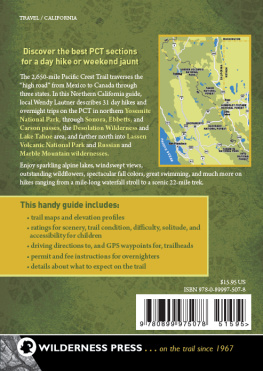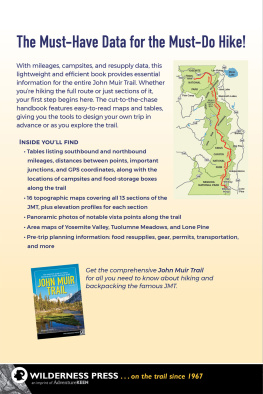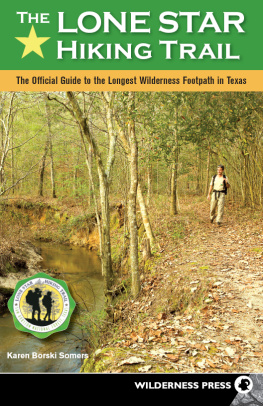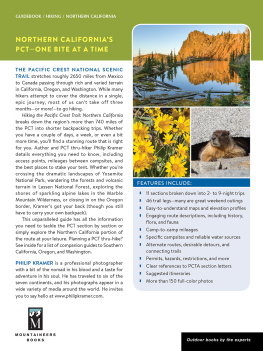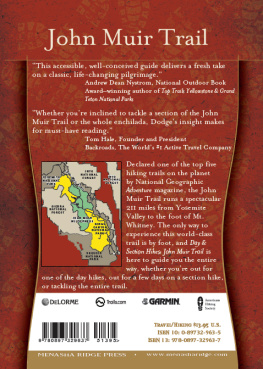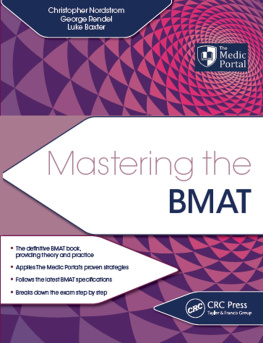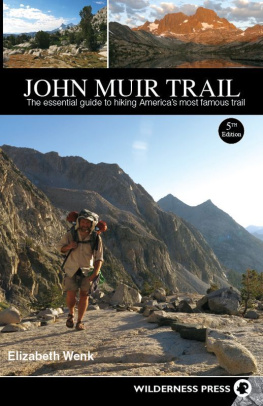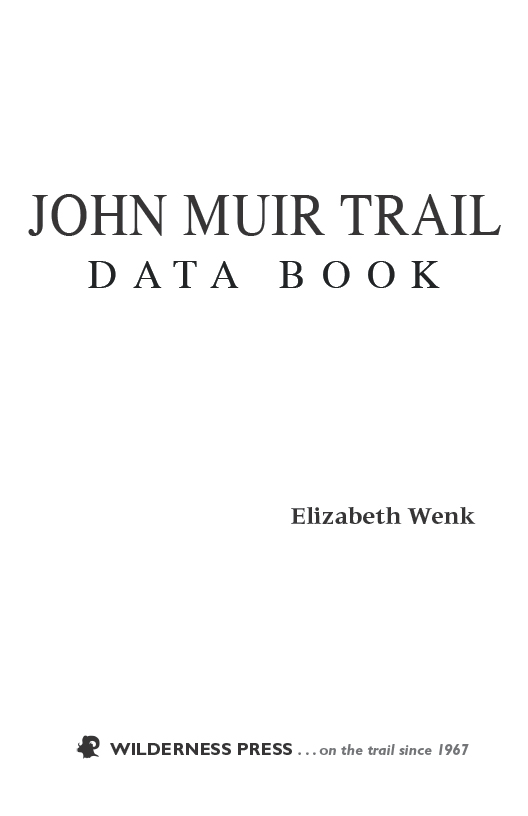Other titles of interest:
John Muir Trail: The Essential Guide to Hiking Americas Most Famous Trail
John Muir Trail: Special Digital-Only Edition for Northbound Hikers
Pacific Crest Trail: Southern California
Pacific Crest Trail: Northern California
Pacific Crest Trail: Oregon & Washington
Pacific Crest Trail Data Book
Day & Section Hikes Pacific Crest Trail: Southern California
Day & Section Hikes Pacific Crest Trail: Northern California
Day & Section Hikes Pacific Crest Trail: Oregon
Day & Section Hikes Pacific Crest Trail: Washington
One Best Hike: Mt. Whitney
John Muir Trail Data Book
1st Edition
Copyright 2014 by Wilderness Press
Front and back cover photos copyright 2014 by Elizabeth Wenk
Unless otherwise noted, all interior photos by Elizabeth Wenk
Maps: Elizabeth Wenk
Cover design: Scott McGrew
Editor: Amber Kaye Henderson
ISBN: 978-0-89997-770-6; eISBN: 978-0-89997-771-3
Manufactured in the United States of America
Published by: Wilderness Press
c/o Keen Communications
PO Box 43673
Birmingham, AL 35243
800-443-7227; FAX 205-326-1012
wildernesspress.com
Visit our website for a complete listing of our books and for ordering information.
Distributed by Publishers Group West
Front cover: Ascending the west side of Mt. Whitney
Back cover: Lake near the Bench Lake Ranger Station
All rights reserved. No part of this book may be reproduced in any form, or by any means electronic, mechanical, recording, or otherwise, without written permission from the publisher, except for brief quotations used in reviews.
SAFETY NOTICE: Although Wilderness Press and the author have made every attempt to ensure that the information in this book is accurate at press time, they are not responsible for any loss, damage, injury, or inconvenience that may occur to anyone while using this book. You are responsible for your own safety and health while in the wilderness. The fact that a trail is described in this book does not mean that it will be safe for you. Be aware that trail conditions can change from day to day. Always check local conditions and know your own limitations.
CONTENTS
INTRODUCTION
T he John Muir Trail (or, more simply, the JMT) is one of the worlds premier long-distance hiking trails. A little more than 220 miles in length, it traverses the spine of Californias Sierra Nevada, passing through superb mountain scenery. This is a land of 13,000- and 14,000- foot peaks, of soaring granite cliffs, of lakes by the thousands, and of canyons 5,000 feet deep. The trail passes near roads only in Tuolumne Meadows and Devils Postpile, otherwise winding through remote mountain landscape. Part of the beauty of this long-distance walk is that the landscape continually changes as you travel from Happy Isles (in eastern Yosemite Valley) to Whitney Portal (west of the town of Lone Pine, in the Owens Valley). Each day you will find new wonders to captivate your attentionrounded domes in Tuolumne Meadows, volcanic features near Devils Postpile, magical hemlock forests near Silver Pass, dashing cascades along Bear Creek, the glacial landscape of Evolution Basin, the near-vertical peaks of the Palisades, carpets of alpine flowers around Pinchot Pass, spectacular lake basins such as the Rae Lakes, scattered foxtail pines on Bighorn Plateau, and of course the views from the summit of Mt. Whitney, Californias tallest peak. The Sierra is an especially lovely area for a multi-week hike, for it is blessed with the mildest, sunniest climate of any major mountain range in the world. Though rain does fall in the summer, it seldom lasts more than an hour or two, and the sun is out and shining most hours of the day. Most likely the greatest challenge you will face is the logistics of resupplying food because the southern 160 miles do not pass a road, and for the final 110 miles you do not even pass close to a food resupply depot. You are, of course, not the only person to have heard of these attractions and will encounter people daily, but the trail really is a thin line through a vast land; with little effort you can always camp on your own if you leave the trail.
Using This Book
This book is an abbreviated version of John Muir Trail: The Essential Guide to Hiking Americas Most Famous Trail , also published by Wilderness Press. This title includes only the data sections of its parent book, including tables with junction locations and distances between junctions, a table of campsite locations, topographic maps, and some basic information to help you plan your trip. If you are seeking a trail description, natural history of the region, possible side trips along the trail, or information on how to hike in the Sierra, I recommend that you purchase the thicker volume; if it proves to be too heavy for the trail, you can keep it for your library and carry a copy of this book.
The goal of this guide is to provide you with the data you need to design your own trip, in advance or as you walk. Some people hike only 7 miles a day while others happily cover more than 20. Some hikers complete the entire trail in one go, while others hike a section at a time. This book should cater to everyone, for it provides information on distances along the trail, established camping locations, stretches of trail with steep ascents and descents, and lateral trails that access the JMT. From there, you design the itinerary that best suits you.
The introductory material provides information on three essential topics: how to obtain a wilderness permit, how to get yourself to and from the two endpoints using either public transportation or a private shuttle, and how to arrange food resupplies along the trail. All the phone numbers and Web addresses required for your planning are supplied. Also provided are maps of Yosemite Valley, Tuolumne Meadows, and Lone Pine to orient you at trailheads.
Next are 17 topographic maps, onto which trail junctions and (listed beginning) have been plotted.
The topographic maps are followed by the trail data. Mimicking the organization of the larger JMT book, the trail information is split into 13 sections, one for each of the river drainages through which the JMT passes. Each section includes a detailed elevation profile of the trail and a table listing major waypoints, including most trail junctions. Each entry includes the elevation, UTM coordinates, distance from the previous point, and cumulative distance from the JMT endpoints, here given as Happy Isles and Whitney Portal. Elevations, with the exception of those benchmarked by the USGS, have been rounded to the closest 10 feet. The UTM coordinates follow the North American datum 1927, as this is the reference system used on most USGS 7.5-minute maps (as well as the popular Tom Harrison maps). GPS devices and mapping software packages use NAD 1983 as a default, but the coordinates can easily convert between the two reference systems.
At the end of the book is a collection of panoramic photos as well as some extra data tables. The photos have been taken from atop passes, and many of the prominent peaks visible are labeled. Following the panoramas is a table listing established, legal campsites. For each campsite, information provided includes the cumulative trail distance, the UTM coordinates (again NAD 1927), a brief description, and whether campfires are permitted. This is followed by tables with emergency numbers for the jurisdictions through which the JMT passes and the locations of wilderness ranger stations in Sequoia and Kings Canyon National Parks, as well as a table with the locations of permanent food-storage lockers (colloquially known as bear boxes). The final table lists basic information on lateral trails feeding into the JMT, which is useful if you plan to section-hike the JMT or if you unexpectedly need to exit the wilderness and need to determine the most efficient way to exit.

